- Clone
- 39E10 (See other available formats)
- Regulatory Status
- RUO
- Other Names
- Microtubule-associated protein tau, PHF-tau, Paired Helical Filament tau
- Previously
-
Covance Catalog# MMS-5017
- Isotype
- Mouse IgG1, κ
- Ave. Rating
- Submit a Review
- Product Citations
- publications
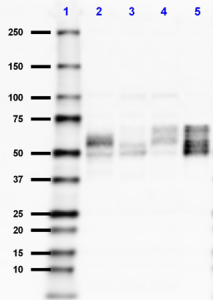
-

Western blot of purified anti-Tau, 189-195 antibody (clone 39E10). Lane 1: Molecular weight marker; Lane 2: 20 µg of normal human brain lysate; Lane 3: 20 µg of mouse brain lysate; Lane 4: 20 µg of rat brain lysate; Lane 5: 0.1 µg of recombinant human Tau protein ladder. The blot was incubated with 1 µg/mL of the primary antibody overnight at 4°C, followed by incubation with HRP labeled goat anti-mouse IgG (Cat. No. 405306). Enhanced chemiluminescence was used as the detection system.
| Cat # | Size | Price | Quantity Check Availability | Save | ||
|---|---|---|---|---|---|---|
| 814302 | 25 µL | 90€ | ||||
| 814301 | 100 µL | 220€ | ||||
Tau protein promotes microtubule assembly and stability. Tau is abundant in neurons of the central nervous system, and is expressed at low levels in astrocytes and oligodendrocytes. Abnormal hyper-phosphorylation, aggregation, and toxic gain of function of tau is associated with several neurological disorders, including Alzheimer’s disease (AD). The major building block of neurofibrillary lesions in AD brains consists of paired helical filaments (PHFs) of abnormally hyperphosphorylated tau. Six isoforms of tau are generated by alternative splicing of the MAPT gene. These isoforms are distinguished by the number of tubulin binding domains, 3 (3R) or 4 (4R), in the C-terminal of the protein and by one (1N), two (2N), or no (0N) inserts in the N-terminal domain. Tau isoforms are differentially expressed during development.
Product DetailsProduct Details
- Verified Reactivity
- Human, Mouse, Rat
- Antibody Type
- Monoclonal
- Host Species
- Mouse
- Immunogen
- This monoclonal antibody was raised against full-length human tau.
- Formulation
- Phosphate-buffered solution (no preservatives or carrier proteins).
- Preparation
- The antibody was purified by affinity chromatography.
- Concentration
- 1.0 mg/ml
- Storage & Handling
- This antibody should be handled aseptically as it is free of preservatives such as Sodium Azide. Store this antibody undiluted between 2°C and 8°C. Please note the storage condition for this antibody has been changed from -20°C to between 2°C and 8°C. You can also check the vial label or CoA to find the proper storage conditions.
- Application
-
WB - Quality tested
- Recommended Usage
-
Each lot of this antibody is quality control tested by Western blotting. For Western blotting, the suggested use of this reagent is 1.0 - 10 µg per ml. It is recommended that the reagent be titrated for optimal performance for each application.
- Application Notes
-
This antibody is effective in immunoblotting (WB).
BioLegend is the Exclusive Provider of this Antibody Product - Application References
-
- Michalski V, et.al. Neurobiol Aging. 2015. 36(12):3131. (WB) PubMed
- Product Citations
-
- RRID
-
AB_2715844 (BioLegend Cat. No. 814302)
AB_2715844 (BioLegend Cat. No. 814301)
Antigen Details
- Structure
- Unmodified Tau isoforms have an apparent molecular weight ranging from 33-79 kD. Additional high and low molecular weight Tau species have been observed in brain tissues.
- Distribution
-
Tissue distribution: Central nervous system, peripheral ganglia and nerves, kidney, skeletal, and heart muscle.
Cellular distribution: Cytoskeleton, nucleus, plasma membrane, and cytosol. - Function
- Tau promotes microtubule assembly and stability. The short tau isoforms allow plasticity of the cytoskeleton whereas the longer isoforms may preferentially play a role in its stabilization.
- Interaction
- Tau interacts with: Sequestosome-1, Peptidyl-prolyl cis-trans isomerase FKBP4, Casein kinase I isoform delta, Serine/threonine-protein kinase Sgk1, Laforin, and alpha-synuclein.
- Biology Area
- Cell Biology, Neurodegeneration, Neuroscience, Protein Misfolding and Aggregation
- Molecular Family
- Tau
- Antigen References
-
1. Meredith JE Jr, et al. 2013. PLoS One. 8(10): e76523. PubMed
2. Goodall CA, et al. 2006. J. Neurol. Neurosurg. Psychiatry 77(1): 89. PubMed
3. Wang Y, Mandelkow E. 2016. Nat. Rev. Neurosci. 17(1):5-21. PubMed - Gene ID
- 4137 View all products for this Gene ID
- Specificity (DOES NOT SHOW ON TDS):
- Tau 189-195
- Specificity Alt (DOES NOT SHOW ON TDS):
- Tau, 189-195
- App Abbreviation (DOES NOT SHOW ON TDS):
- WB
- UniProt
- View information about Tau 189-195 on UniProt.org
Other Formats
View All Tau, 189-195 Reagents Request Custom Conjugation| Description | Clone | Applications |
|---|---|---|
| Purified anti-Tau, 189-195 | 39E10 | WB |
| Biotin anti-Tau, 189-195 | 39E10 | WB,Direct ELISA |
| HRP anti-Tau, 189-195 | 39E10 | WB |
Customers Also Purchased

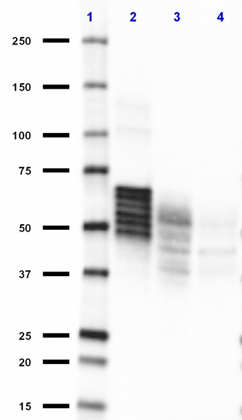
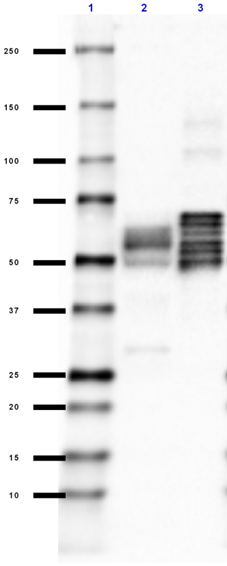
Compare Data Across All Formats
This data display is provided for general comparisons between formats.
Your actual data may vary due to variations in samples, target cells, instruments and their settings, staining conditions, and other factors.
If you need assistance with selecting the best format contact our expert technical support team.
-
Purified anti-Tau, 189-195
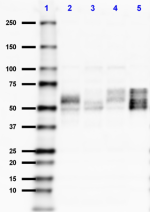
Western blot of purified anti-Tau, 189-195 antibody (clone 3... -
Biotin anti-Tau, 189-195
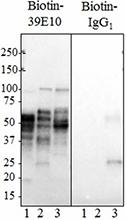
Western blot of biotin anti-Tau, 189-195 antibody (clone 39E... 
Direct ELISA of biotin anti-Tau, 189-195 antibody (clone 39E... -
HRP anti-Tau, 189-195
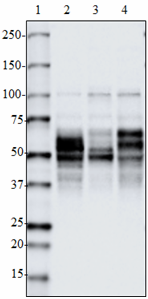
Western blot of HRP anti-Tau, 189-195 antibody (clone 39E10)...
 Login / Register
Login / Register 













Follow Us